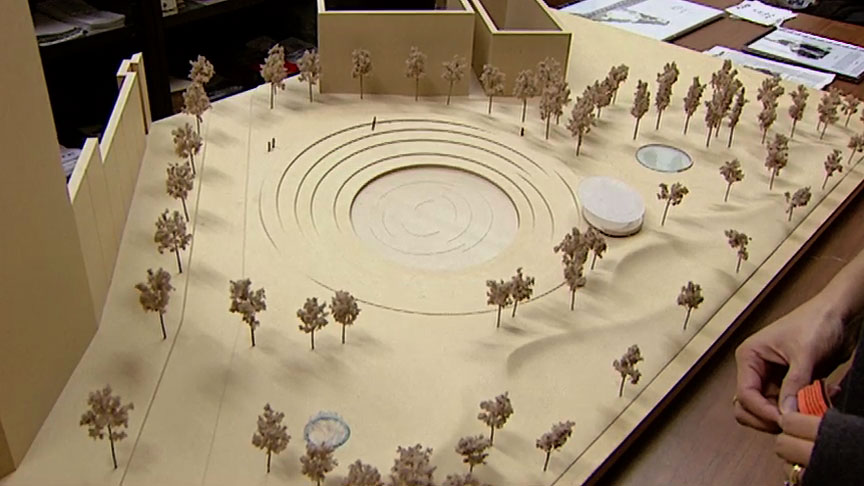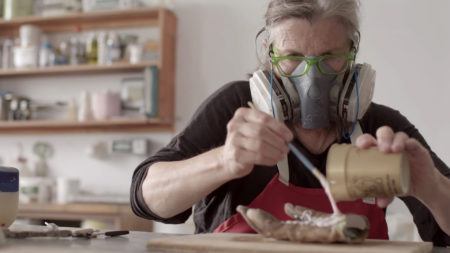Interview
Grand Rapids Ice Rink and Park Project

Model for Rosa Parks Circle (Grand Rapids, MI) in Maya Lin's Manhattan studio, New York, NY, 2000. Production still from the "Art in the Twenty-First Century" Season 1 episode, "Identity," 2001. © Art21, Inc. 2001.
Maya Lin discusses her process of designing a monument for a park in Grand Rapids, Michigan.
ART21: What was the initial concept you had in mind for the Grand Rapids park project? What was in your mind’s eye?
LIN: It’s funny, whenever I start—I have no idea why I end up creating each of these site-specific works. I think [what is] atypical is that—you might look at Eclipsed Time, you might then go visit The Wave Field, or Groundswell, or even what’s going on in Grand Rapids—materially and formally, they’re very different. The mediums I use range widely, from broken glass to water to granite. And I think, formally—each time out with these large-scale works—they can look very different. But there are some very strong, underlying ideas that go throughout the works. One of them is time; one of them is an idea about landscape and the earth, or natural states or phenomena. So I think, for me, Grand Rapids is also very contextually site-specific; it’s not just a reaction to a physical site, it’s the cultural site.
So, with the The Wave Field in Michigan, it was for an aerospace engineering building, and I had no idea what I was going to do. My site could have been in the building they were building or outside. And I just read up on aerospace and flight for three months and then came up with the idea of The Wave Field, which is basically a book image of a naturally occurring water wave that came about because flight requires resistance, and that led to turbulence studies, which led to fluid dynamics.
For Grand Rapids, I think I started thinking about the city and its proximity—it’s two blocks away from the river that gave it its name. The Army Corps of Engineers broke the rapids, so that the city would stop flooding. I just started thinking in the back of my head about water. I think I have used water in many of my pieces, and when I’m not using water, like The Wave Field, it’s a recreation of a water wave. Groundswell—the definition of ground swell is the beginning swell in the ocean before it makes a wave. And the color of the glass—I deliberately mixed two colors to get a color like water.
So, for Grand Rapids, I just started with an intuition, and I started playing with it. I’d actually started with frozen waves of earth, kind of taking where I left off with The Wave Field, and that grew into an early Plasticine model that deals with water fountains: one liquid, one gas, one vapor. The ice-skating rink—which I always knew was going to be a large physical part of the site—I knew would become my focal point. So, that’s probably what I would say is the initial underground, subconscious idea I might be toying with. I don’t think you can say, “because of this, I did this; because of this, I did that.” I think art is wonderful because it’s everything you’ve ever known and everything you’ve ever done, somehow percolating up, working with ideas that you might want to explore. And then you can just wake up one morning and know what you want to do—the hissing of the heat.

Construction site for Rosa Parks Circle, Grand Rapids, MI, 2000. Production still from the “Art in the Twenty-First Century” Season 1 episode, “Identity,” 2001. © Art21, Inc. 2001.
ART21: How much were you influenced by the Ohio mound-builder culture?
LIN: I think they were always there; there were school trips. I think there are a few things dealing with landscape that have been a very strong influence on my work. One of them is my whole southeastern Ohio topography. There were these ancient mounds built, earth mounds, effigies. Some were ones called the Serpent Mound; it is this beautiful snake. Others were just whole cities, burial mounds. And the Hopewell and Adena [traditions] made and left these two to three thousand years ago. Some are still standing. They’re in cow pastures, corn fields. As a child, you knew they were there. They’d show up in someone’s corn field. But oddly enough, I think influential on me was the landscape itself in southeastern Ohio. (When everyone thinks of Ohio—and they think northern—they think Cleveland.) It is incredibly hilly, and right where I grew up, the landscape just undulates beautifully. And you really do have a sense, always, of that ground plain rising up and rolling. It’s the rolling hills, and they’re quite, quite luscious and quite beautiful.
But as important would probably be the fact that my dad was a potter. And my brother and I, after school—because we were at the university lab school—we’d get out of school at three o’clock and we’d have two hours in my dad’s pottery studio to wait, before he was ready to go home. So, just days, hours spent playing with clay. And I think I would say that so much of my work deals with the plastic medium of clay. Water, again, is a very plastic, fluid medium. My childhood is the ’60s; and the notion of what plastic, fluid, design shapes were beginning to originate out of there, again, plays into the back of your head. But I think for me, it was probably my father’s potting that I would watch. That’s something I really, really played with as a child and was probably more of an influence.

Rosa Parks Circle, Grand Rapids, MI, 2000. Production still from the “Art in the Twenty-First Century” Season 1 episode, “Identity,” 2001. © Art21, Inc. 2001.
ART21: Are there other material influences?
LIN: No, it should be the elements. Why do some materials interest me more than others? Water is an amazing element because it can occur in three states. It can be a solid (ice), a liquid, or it can be a gas (steam). And, again, going back to science, it’s probably why I wanted to become a scientist early on. The ability for water to transform or transmute itself, the fact that it can constantly be in flux as to what it is, is probably why I’m drawn to it. So, that the Grand Rapids park uses ice, vapor, and liquid—water in all its three stages—is absolutely the core idea behind that piece.



